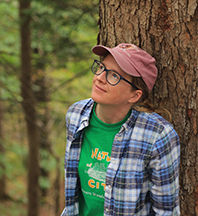Week of March 17, 2024 – March 23, 2024
by Anna Stunkel, Environmental Educator
It’s certainly been a mild winter here in Central New York. Small snowstorms have been interspersed with warm days in the 50s, 60s, or even 70s. With the warm temperatures, early spring birds have been returning in full force. A massive flock of Common Grackles, Red-winged Blackbirds, and Brown-headed Cowbirds descended on the Baltimore Woods feeders on leap day, enjoying an abundant food source as lake effect snow fell. Every now and then over the past few days, I’ve been hearing Killdeer calling from the fields near the Interpretive Center. Huge flocks of robins have been feeding on the Staghorn Sumac berries as well.
In many cases I’ve been seeing these birds arrive around the same time that they usually do, but for some, they’re arriving quite early. This year, early sparrow arrivals are especially prevalent. White-crowned and Field Sparrows have been seen at and around the feeders about a month earlier than usual, and there have also been high numbers of White-throated Sparrows for this time of year. Maybe since many sparrows are short-distance migrants coming from nearby areas, the mild winter in those places has caused them to return early.
While there has been an impressive Snow Goose movement, the location of massive, concentrated groups is harder to predict than in years past. Snow Geese have historically gathered in huge groups in an area of Montezuma known as the Savannah Mucklands. For the past couple of years, this area hasn’t been flooding much in spring and surrounding areas have remained unfrozen, so the geese spread out. As these birds fly northwards through Central New York, their nesting destination is the high Arctic tundra. Climate change could have a serious impact on the vegetation, food availability, and water levels there.
As humans, many of us (including myself) might feel torn about what these changes mean. Taken one day at a time, who doesn’t enjoy a sunny, 70 degree day with birds singing? But these “false springs” can also cause a lot of worry among those of us experiencing climate change anxiety. Instead of becoming too stuck in the negativity of this, we should remember that we can all work towards making a difference. By becoming involved in community decisions, contributing to citizen science, volunteering on stewardship projects like the ones here at Baltimore Woods, and sharing the joy of experiencing nature with others, you can help our local ecosystems.
For example, you can help ornithologists to learn about changes in migration timing by contributing as a citizen scientist. eBird is a free app that you can use to record timing, location, species, and numbers of birds. Scientists analyze the data to learn about how birds’ ranges are shifting over time, and where we should concentrate on conservation efforts. If you’re interested in learning more about bird migration and identification so that you can help in this way, keep an eye on our website for upcoming programs. These include a Montezuma field trip for families on March 23, Derby Hill field trip and stewardship project on April 19, and other bird programs that will be added to the calendar soon.


